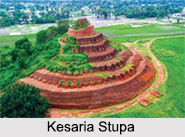 Kesaria Stupa is a Buddhist Stupa which is considered to be the tallest and biggest Buddhist Stupa in the world. This stupa was built by the great ruler Ashoka. This is the place where Lord Buddha in his last days donated his begging bowl. In 1998, the Kesaria Stupa was discovered in the excavation done by Archaeological Survey of India (ASI). The stupa is believed to date back to somewhere between 200 AD and 750 AD.
Kesaria Stupa is a Buddhist Stupa which is considered to be the tallest and biggest Buddhist Stupa in the world. This stupa was built by the great ruler Ashoka. This is the place where Lord Buddha in his last days donated his begging bowl. In 1998, the Kesaria Stupa was discovered in the excavation done by Archaeological Survey of India (ASI). The stupa is believed to date back to somewhere between 200 AD and 750 AD.
Location of Kesaria Stupa
Kesaria Stupa is located at a distance of 110 kilometres from Patna, in the East Champaran district of Bihar.
Structure of Kesaria Stupa
Kesaria Stupa is adorned with a large number of Buddhist statues. However, some of the parts are in ruined state as they were damaged by the invading Muslim rulers. A number of images of Lord Buddha, in "Bhumi Sparsh Mudra" and other sitting postures were also found in the stupa. The structure of Kesaria Stupa serves as a brilliant example of Buddhist architecture.
 Kesaria Stupa has a circumference of almost 1400 feet (430 m) and raises to a height of about 104 feet (32 m). It is believed that initially, the height of the stupa was approximately 150 feet. However, after being subjected to the 1934 earthquake, the stupa got immersed into the ground and was reduced to 123 feet in height. The aftermath of the earthquake further reduced the height of the statue to its current stature, that of 104 ft.
Kesaria Stupa has a circumference of almost 1400 feet (430 m) and raises to a height of about 104 feet (32 m). It is believed that initially, the height of the stupa was approximately 150 feet. However, after being subjected to the 1934 earthquake, the stupa got immersed into the ground and was reduced to 123 feet in height. The aftermath of the earthquake further reduced the height of the statue to its current stature, that of 104 ft.
Legend of Kesaria Stupa
Kesaria Stupa is believed to have been built to honour the place where Lord Buddha had spent the last days of his journey, before attaining Nirvana. It is said that Lord Buddha handed over his begging bowl to the Licchavis, people of Vaishali and requested them to go back to Vaishali, after his death. To venerate the end life of Lord Buddha, the Licchavis are said to have built this stupa. While formerly, it was only a mud stupa, it gained its present structure in the Maurya, Sunga and Kushana period.
Kesaria Stupa serves as a holy site for the Buddhist pilgrims around the world. The Archaeological Survey of India (ASI) has declared the stupa a protected monument of national importance.



















